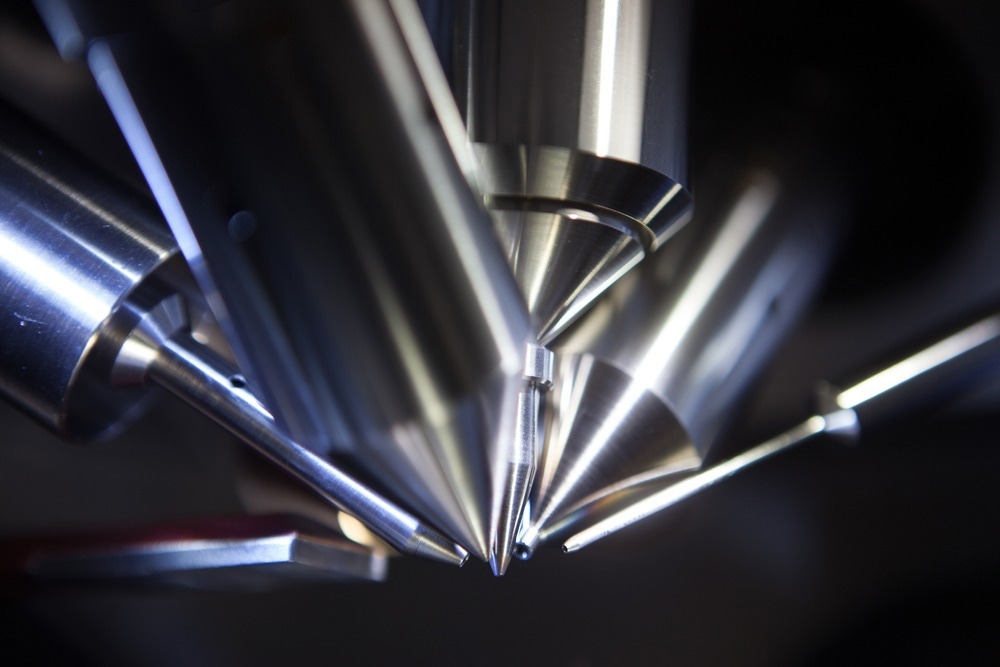Single-cell level protein analysis utilizing mass spectrometry (MS) with picolitre sample volumes needs sensitivity in the range of zeptomole to attomole. An article published recently in the journal Analytical Chemistry discussed an analytical pretreatment method based on a nanofluidic device to downsize the chemical unit operations to the range of femtoliter to picolitre volume in mass spectrometry.

Study: Femtoliter-Droplet Mass Spectrometry Interface Utilizing Nanofluidics for Ultrasmall and High-Sensitivity Analysis. Image credit: Intothelight Photography/Shutterstock.com
Although mass spectrometry has achieved ultra-high sensitivity detection, preventing sample loss and interfacing between femtolitre to picolitre volumes for pretreatment remains a challenging issue. In this study, the researchers utilized a nanofluidic device to achieve a high-sensitivity detection at the MS interface. Followed by charging analyte molecules by the electrodes, the nanofluidic device helped in the conversion of liquid samples to femtoliter droplets.
After the generation of droplets by a nanofluidic device, an inertial force acted on the sample femtoliter volumed droplet to carry it with a controlled trajectory. Finally, the droplet gets injected into the mass spectrometer instrument. A module was designed and constructed for heat transfer which vaporized all the injected droplets into gas-phase ions. Detecting caffeine ions utilizing the designed MS interface based on a nanofluidic device showed a limit of detection (LOD) of 1.52 attomole.
Compared to the conventional mass spectrometry interface that utilizes electrospray ionization, the present interface based on a nanofluidic device achieved 290 times higher efficiency. Moreover, a 100% sample injection rate was achieved through the nanofluidic method, which resulted in a two-fold higher sensitivity. Thus, the developed methodology based on a nanofluidic device facilitated the analysis of samples in ultrasmall quantities with high sensitivity.
Mass Spectrometry Interface for High Detection Sensitivity
Nanofluidic studies fabricate nanofluidic devices or nanopatterning to achieve a small size. It can achieve nanofluidic manipulation for biological structures and nanoparticles at a nanoscale level. MS-based protein analysis at the single-cell level helps elucidate disease mechanisms and cellular expressions.
Nevertheless, these protein analysis processes need the integration of a pretreatment based on a nanofluidic device to prepare ultrasmall sample volumes before their introduction into a mass spectrometer to facilitate dispersion and prevent sample loss. While microfluidics allows chemical operations in 10 to 100 micromolar spaces, nanofluidics exploits 100−1000 nanomolar spaces with femtolitre to picolitre volumes.
Electrospray ionization (ESI) is a widely used MS interface, which involves applying high voltage to a liquid sample followed by spraying the sample through a capillary, via the electrical repulsive force for ionization. Thus, the sample dispersion by spraying caused by ESI reduces the rate of sample injection into the mass spectrometer, consequently reducing the sensitivity. To this end, nanoESI had reduced capillary size and was extensively used for enhanced sensitivity.
Moreover, MS interfaces utilizing ultrasonic waves and laser ablation to vaporize and eject liquid samples were reported. The piezoelectric interface is another method that shoots sample droplets like an inkjet printer. However, droplets of nanoliter volume are too large to produce gas-phase ions by vaporizing the sample solution.
Femtoliter-droplet MS Interface Utilizing Nanofluidic Device
In their previous work, the team developed a microfluidic device, which utilized a two-step airflow to convert the liquid sample into uniform droplets, followed by their ejection into the air with a controlled trajectory. The droplets generated in this study were of volume between 4 and 25 picolitres. However, this volume range was too large for vaporization.
In the present study, an MS interface based on a nanofluidic device was developed to generate ultrasmall droplets and achieve high-sensitivity analyses, wherein femtoliter-droplet shooter was utilized without sample dispersion. An analytical system was developed with a nanofluidic device integrated MS interface based on a single quadrupole mass spectrometer to prove this principle.
Through the MS interface, which was based on a nanofluidic device, femtoliter droplets were generated. The force that acted on the generated sample droplets carried them with a controlled trajectory and injected them into a mass spectrometer with 100% efficiency. Later, the constructed heat transfer module vaporized the droplets to produce gas-phase ions.
The constructed MS system integrated with an MS interface based on a nanofluidic device helped evaluate the MS detection sensitivity. Results were compared to that of conventional ESI-MS. The results confirmed that the constructed MS interface based on a nanofluidic device detected ultrasmall samples with ultrahigh sensitivity.
What Did the Study Find?
To summarize, the nanofluidic device-based MS interface method was developed to generate femtoliter droplets, which were ejected with a controlled trajectory to achieve high-sensitivity detection. Furthermore, the heat transfer thermal system achieved 100% vaporization of droplets injected into MS's aperture.
The voltage applied increased the charge imposition efficiency in the sample liquid and the results revealed that the MS interface based on a nanofluidic device achieved high-sensitive MS detection. The ionized caffeine showed 290 times higher sensitivity of detection than conventional ESI due to the achieved femtoliter droplet via MS interface based on a nanofluidic device.
Reference
Takagi, Y., Kazoe,Y., Morikawa,K., Kitamori,T. (2022) Femtoliter-Droplet Mass Spectrometry Interface Utilizing Nanofluidics for Ultrasmall and High-Sensitivity Analysis. Analytical Chemistry. https://pubs.acs.org/doi/10.1021/acs.analchem.2c01069
Disclaimer: The views expressed here are those of the author expressed in their private capacity and do not necessarily represent the views of AZoM.com Limited T/A AZoNetwork the owner and operator of this website. This disclaimer forms part of the Terms and conditions of use of this website.